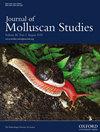不仅仅是眼前所见:描述新加坡珊瑚礁生活的裸枝Pteraeolidia“semperi”(裸枝:Aeolidioididea)中的隐蔽物种复合体和共生菌科群落
IF 1.2
4区 生物学
Q2 MARINE & FRESHWATER BIOLOGY
引用次数: 0
摘要
分子系统学的出现彻底改变了我们对生物多样性的认识,揭示了生命之树上未被发现的神秘谱系。相应地,通过综合分类学方法发现并描述了越来越多的裸枝类物种复合体。Pteraeolidia‘semperi’(Nudibranchia:Cladobranchia:Aeolidioidea)目前代表了一个复杂的物种,具有模糊的系统学和被低估的多样性。基于从新加坡南部水域采集的48个“森佩里”P.样本的细胞色素c氧化酶亚基I标记的测序和系统发育重建,以及包括雷达扫描电子显微镜在内的形态分析,表明“森佩里”P.包括几个不同的隐世谱系。我们使用内部转录的间隔区2基因的代谢编码进一步表征了来自新加坡的P.'semperi'的共生菌科群落。来自新加坡的Pteraeolidia‘semperi’被发现主要寄主Cladocopium和Durusdinium共生体,并且具有显著的生物地理学结构。这项研究阐明了新加坡P.'semperi'目前的分类多样性,并有助于研究与这个神秘分类单元相关的藻类共生体的多样性。本文章由计算机程序翻译,如有差异,请以英文原文为准。
More than meets the eye: characterizing the cryptic species complex and Symbiodiniaceae communities in the reef-dwelling nudibranch Pteraeolidia ‘semperi’ (Nudibranchia: Aeolidioidea) from Singapore
The advent of molecular systematics has revolutionized our knowledge of biodiversity, revealing undiscovered cryptic lineages across the tree of life. Correspondingly, an increasing number of nudibranch species complexes have been found and described through integrative taxonomic approaches. Pteraeolidia ‘semperi’ (Nudibranchia: Cladobranchia: Aeolidioidea) presently represents a species complex, possessing ambiguous systematics and an underestimated diversity. Sequencing and phylogenetic reconstructions based on the cytochrome c oxidase subunit I marker from 48 samples of P. ‘semperi’ collected from Singapore's southern waters, as well as morphological analyses including scanning electron microscopy of the radula, suggest that P. ‘semperi’ comprises several distinct cryptic lineages. We further characterized the Symbiodiniaceae communities of P. ‘semperi’ from Singapore using metabarcoding of the internal transcribed spacer 2 gene. Pteraeolidia ‘semperi’ from Singapore was found to predominantly host Cladocopium and Durusdinium symbionts, and was significantly structured by biogeography. This study elucidates the present taxonomic diversity of P. ‘semperi’ in Singapore and contributes to the growing body of work on the diversity of algal symbionts associated with this enigmatic taxon.
求助全文
通过发布文献求助,成功后即可免费获取论文全文。
去求助
来源期刊

Journal of Molluscan Studies
生物-动物学
CiteScore
3.00
自引率
8.30%
发文量
36
审稿时长
3 months
期刊介绍:
The Journal of Molluscan Studies accepts papers on all aspects of the study of molluscs. These include systematics, molecular genetics, palaeontology, ecology, evolution, and physiology. Where the topic is in a specialized field (e.g. parasitology, neurobiology, biochemistry, molecular biology), submissions will still be accepted as long as the mollusc is the principal focus of the study, and not incidental or simply a convenient experimental animal. Papers with a focus on fisheries biology, aquaculture, and control of molluscan pests will be accepted only if they include significant advances in molluscan biology. While systematic papers are encouraged, descriptions of single new taxa will only be considered if they include some ‘added value’, for example in the form of new information on anatomy or distribution, or if they are presented in the context of a systematic revision or phylogenetic analysis of the group.
 求助内容:
求助内容: 应助结果提醒方式:
应助结果提醒方式:


